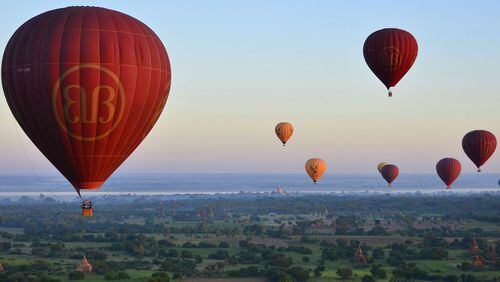When I worked as a journalist in Southeast Asia in the ‘90s, many parts of the region were still undeveloped and untraveled.
Today, this part of the world is modernizing at an accelerated pace, and much of the ancient culture is vanishing.
Last winter I went searching for the primal Southeast Asia I remembered and loved, and I found it in two relatively unspoiled destinations: Myanmar and the Indonesian island of Sulawesi.
My voyage back in time began in one of the area’s most modern cities, Singapore. A blend of East and West, this island city-state full of ethnic neighborhoods is an ideal spot for travelers to acclimate to Asia.
After a couple of days in Singapore enjoying the scent of flower garlands, spices and incense in Little India, feasting on chicken rice and other street food delights at Maxwell Road Hawker Centre in Chinatown, and touring the quaint colonial homes in the Muslim Quarter, my photographer and I were ready for the first leg of our journey: Myanmar.
Military rule all but shut down tourism and economic growth in Myanmar from 1962 to 2011. The former capital, Yangon, is one of the few cities even partially modernized. The clock stopped here at the end of British rule, leaving behind mostly colonial-era buildings and an antiquated rail system. We stayed in one of these beautiful architectural wonders, the Strand Hotel, which recently had a face-lift but maintains its turn-of-the-century charm. Overnight rates from $313; www.hotelthestrand.com.
We also took a ride on the famed Circle Line train that runs around the city at a speed just above walking pace. This old-school excursion gave us our first taste of true Myanmar, as just outside of Yangon paved roads turn to dirt and ox carts replace cars.
Our next stop and primary destination, the ancient city of Bagan, likely looks much as it did in the days when British author George Orwell worked for the Indian Imperial Police in what was then Burma. Bagan is a popular tourist destination, thanks largely to its 2,000-plus Buddhist temples, pagodas and monasteries scattered across the village on the banks of the Irrawaddy River.
It was my photographer's birthday, so we opted for the most spectacular way to view the temples, via a hot air balloon. Balloons Over Bagan ($330 a person, www.balloonsoverbagan.com) has been taking guests on lofty rides over the temple fields since 1997.
Before dawn, we met Robert, our balloon pilot, on a grassy field. We boarded our craft and rose into the air just as the horizon started to glow in the fiery light of the coming day. As we drifted toward the first of the temples, the sun bathed the old buildings with golden rays.
Our next adventure, a cruise up the Irrawaddy from Bagan to the fabled city of Mandalay, was equally mesmerizing. The intimate, luxury river vessel Belmond Road to Mandalay holds a maximum of 82 guests (two-night cruises start at $1,500 a person; www.belmond.com/road-to-mandalay-myanmar). As we glided upriver, we were greeted with the sights and sounds of fishermen throwing hand nets and merchants plying the swirling, silt-laden waters in all forms of primitive crafts.
The captain, when he wasn’t keeping us clear of dangerous sand bars, explained that the river is so shallow and variable, he has to send his men out in a small skiff to mark the channel with bamboo poles so he won’t run aground.
This magical voyage made several delightful stops along the way, including the fabled Mingun temple, said to have the largest ringing bell in the world; the former British colonial hill station at Maymyo; the ancient imperial capital city of Inwa; and volcanic Mount Popa, with its 777 steps leading to a sacred monastery at the summit.
One of my favorite excursions was at Taungthaman Lake, just outside of Mandalay. We boarded a small skiff and enjoyed a glass of Champagne while watching the sunset behind the lengthy teakwood expanse of U Bein Bridge.
For an even more intense foray into the mysteries of ancient Myanmar, Burma Boating offers sailing adventures through the Mergui Archipelago off Myanmar's far southwest coast. Limited to 10 guests, these high-end excursions drop by some of the most remote populated islands in Southeast Asia. The tour includes encounters with village locals, swimming at magical deserted beaches and indulging in multicultural delicacies prepared by the on-board chef. Five-night cruises start at $2,600 a person, www.burmaboating.com.
After stepping back in time in Myanmar, we visited one of the last outposts of Indonesia that remains unspoiled by the march of progress. The island of Sulawesi between Borneo and New Guinea looks like the Bali of old, before its beaches became littered with mega resorts and partying tourists.
All you'll find in Sulawesi are jungle, sea, sand and a few small fishing villages. We were headed to an end-of-the-world oasis called Wakatobi, a dive resort on a tiny island southeast of Sulawesi. The resort and its handful of tasteful bungalows situated on a perfect white sand beach are nothing less than amazing, especially if you love diving and snorkeling. Sulawesi's unspoiled waters brim with perfectly pristine reefs and varied marine life. Rates, including meals, start at $290 a person; www.wakatobi.com.
These two wonderful locations assured me that the Southeast Asia I remember from my past isn’t gone forever. One can only hope it will stay that way.






